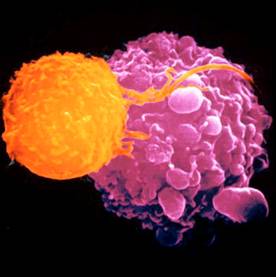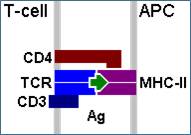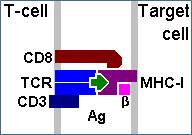BiteSized Immunology: Cells

Helper and Cytotoxic T Cells
Principles of the Assay
T cells are so called because they are predominantly produced in the thymus. They recognise foreign particles (antigen) by a surface expressed, highly variable, T cell receptor (TCR). There are two major types of T cells: the helper T cell and the cytotoxic T cell. As the names suggest helper T cells ‘help’ other cells of the immune system, whilst cytotoxic T cells kill virally infected cells and tumours.
Unlike antibody, the TCR cannot bind antigen directly. Instead it needs to have broken-down peptides of the antigen ‘presented’ to it by an antigen presenting cell (APC). The molecules on the APC that present the antigen are called major histocompatibility complexes (MHC). There are two types of MHC: MHC class I and MHC class II. MHC class I presents to cytotoxic T cells; MHC class II presents to helper T cells.

The binding of the TCR to the MHC molecule containing the antigen peptide is a little unstable and so co-receptors are required. The CD4 co-receptor (first image, below) is expressed by helper T cells and the CD8 co-receptor (second image, below) by cytotoxic T cells. Although most T cells express either CD4 or CD8, some express both and proportion do not express either (“double negative” (DN)). Most T cells are defined as CD4 or CD8 but some are classified into additional types such as invariant Natural Killer T cells (iNKT), and Mucosal Associated Invariant T cells (MAIT).


The TCR is made up of multiple chains to assist the transmission of the signal to the T cell. These chains are alpha + beta. The majority of T cells are alpha-beta T cells but alpha-alpha T cells do exist. There is also a special group of T cells with gamma and delta chains instead of alpha and beta called gamma-delta (γδ) T cells. In order for the stimulus of antigen binding to the TCR to be relayed into the T cell, the TCR is associated with the protein complex CD3 which is made up of four types of chains including two epsilon chains, two zeta chains, one delta and one gamma chain.
© The copyright for this work resides with the author.
